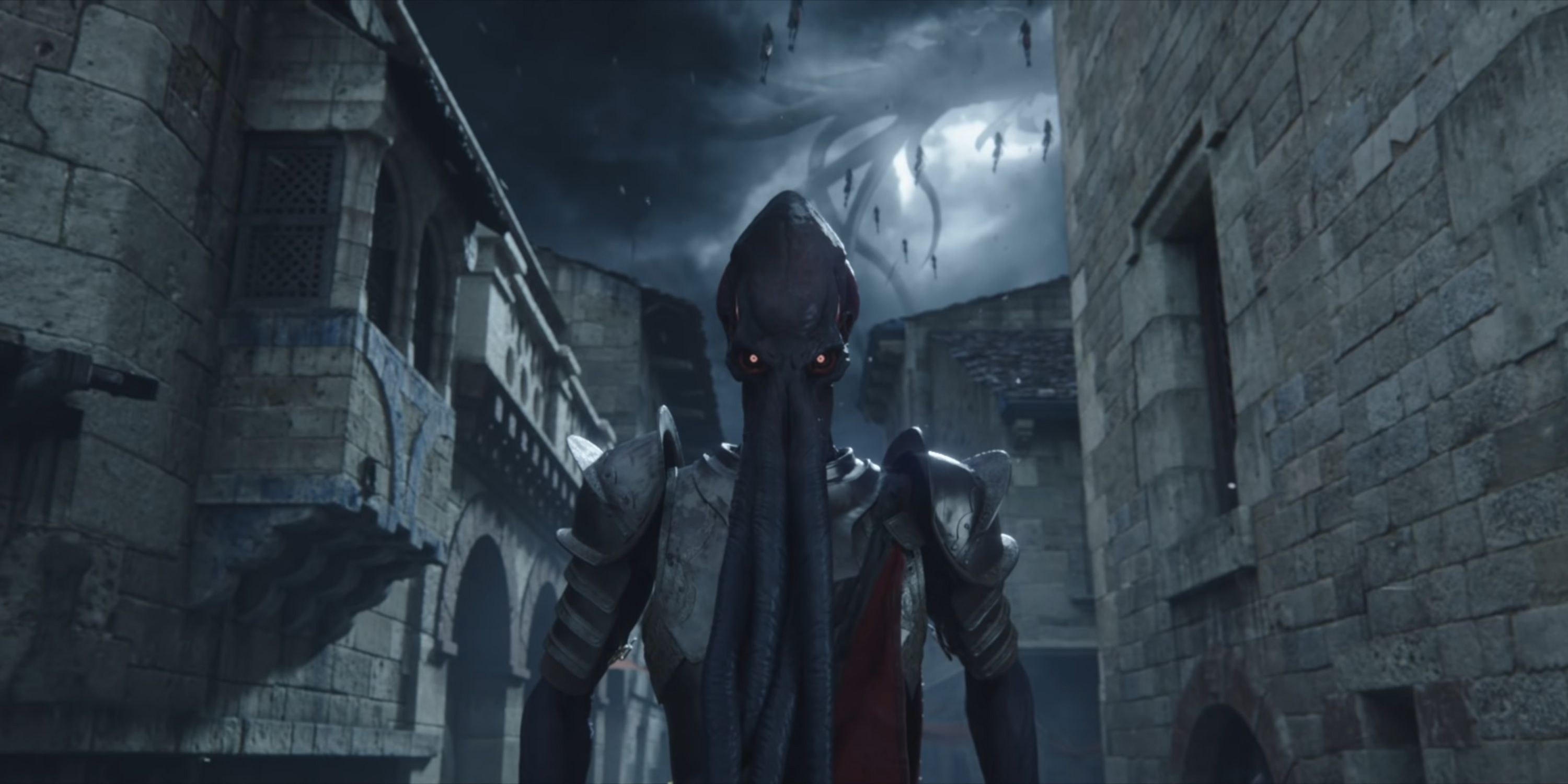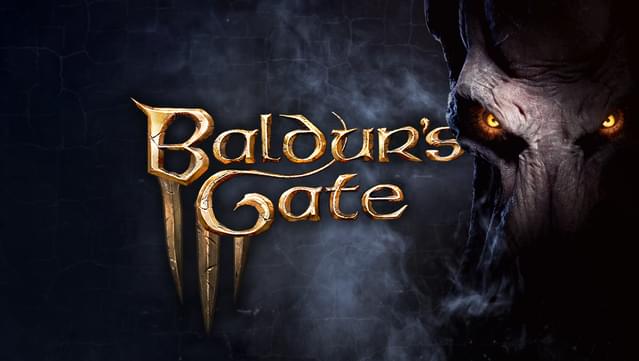Baldur’s Gate 3 Officially Announced for PC and Google Stadia
Gather your party and venture back to D&D’s classic Sword Coast.
Baldur’s Gate 3 is real. Almost twenty years after the story of the original games concluded in the Throne of Bhaal expansion, we’re finally revisiting one of the most important cities in the history of RPGs. And, as if that weren’t exciting enough, Baldur’s Gate 3 is being developed as a Google Stadia and PC game by Larian Studios; the Belgian team responsible for the wildly ambitious Divinity: Original Sin 2.
As revealed during the Google Stadia Connect, which revealed Google Stadia’s price, launch month, and more, right now all Larian has to show is a CGI Baldur’s Gate 3 trailer that, while not revealing any gameplay, sets the tone and introduces us to two key elements that will clearly play a major part in Baldur’s Gate 3’s story: Mind Flayers and Nautiloids.
Baldur’s Gate 3: Flaming Fist, Mind Flayer and Nautiloid
In the trailer we see a Flaming Fist, one of the law keepers of Baldur’s Gate, stagger through the streets of the titular city. In a grisly, Cronenberg-esque display, he transforms into a Cthulhu-like Mind Flayer; a powerful psionic denizen of the Underdark that feeds on brains. In the closing moments of the video, the sky erupts with lightning, revealing the imposing silhouette of a Nautiloid; colossal, tentacled vessels employed by Mind Flayers to travel through the Astral Plane.
This tells us a lot, not least that Larian appears to be pulling inspiration from Spelljammer; the Dungeons & Dragons campaign that sees fantasy heroes take to the stars and explore other worlds.
While the game has been in production for some time now, Larian is not yet in a position to share very much, and what it can say is being kept vague. “It’s our biggest game ever,” the studio’s CEO, Swen Vincke, tells IGN. “It’s not what you expect it to be. It’s going to be spectacular and grand. It’s going to feature lots of tough decisions and memorable companions. It’s going to be challenging, it’s going to have a lot of systems. There will be a lot of stuff for you to explore and exploit. And you will be able to play in single and multiplayer.”

Dungeons & Dragons Roots
While Larian is looking to subvert what players expect from a game set in the typically traditional Forgotten Realms, Baldur’s Gate 3 remains entirely rooted in established Dungeons & Dragons lore. “Mind Flayers are very much part of Forgotten Realms, and they actually featured in the previous Baldur’s Gate,” Vincke says. “But we’re going to go to places which have maybe not been visualized as strongly as we’re going to be visualizing them.”
For example, the trailer demonstrates ceremorphosis, the process in which a parasite converts a host into a Mind Flayer. This transformation exists in the lore already, but has never been described. For Baldur’s Gate 3, Larian’s senior writer Adam Smith has been able to write, in horrifying detail, what happens during each day of the process.
“You’re going to find out things that people have been wondering about in the lore,” Vincke promises. “There’s going to be some answers given that haven’t yet been given.”
This is one example of the very trusting relationship that Larian has struck up with Wizards of the Coast, the company that owns Dungeons & Dragons. “We are totally free [to do what we want],” Vincke says. “The agreement is that we respect their lore, and that we base ourselves in D&D 5th edition, otherwise we wouldn’t be doing it. They want us to make a really good video game that feels like you’re playing Dungeons & Dragons on your computer, alone or with friends. And so that’s really what we want to make.”
Baldur’s Gate 3 being set in Dungeons & Dragons’ 5th edition is an interesting point, since it means there will have to be several distinct differences between it and Baldur’s Gate 2, which adopted Advanced Dungeons & Dragons’ 2nd edition rules. Chief among these is the fact that Baldur’s Gate 3 has to be set over 100 years after Baldur’s Gate 2, as each edition of D&D pushes the timeline forward.

While Baldur’s Gate 3’s storyline will, presumably, begin around 1489 DR of the Forgotten Realms calendar, Larian’s journey to the city began just after the release of Divinity: Original Sin in 2014. “I approached Wizards for the first time after Original Sin,” Vincke recounts. “And they said that we were too green. But we talked at length about what our ideas were and what our philosophy was.”
It was during the development of Divinity: Original Sin 2 that Larian was finally able to strike a deal with Wizards of the Coast. The team was asked to provide a design document, which they wrote over the course of a weekend. “It wasn’t very good,” Vincke laughs. “They also said it was not very good. We said ‘We know it’s not very good, but we’re slightly busy right now,’”
When Larian was finally able to put together a design for something worthy of the name Baldur’s Gate, Wizards of the Coast gave the team the go ahead. “They just let us do it. We have a lot of freedom,” Vincke says. “And it’s working out pretty well, I have to say.”
While Larian has no gameplay it is ready to show, Vincke describes the game as “Larian Dungeons & Dragons”, which at least to my mind sounds something different to ‘Divinity set in the Forgotten Realms’. “This is us making an RPG in the universe that we love,” he says. “We’re the GMs in this case. We’re using Dungeons and Dragons rules but we’re the game masters.”
This is all very exciting, but you have to question why Larian would want to make a D&D game when they have their own original IP in Divinity. While it’s true that Rivellon is less well-known as a setting, it’s certainly as rich anything in the Dungeons & Dragons universe. But Vincke explains that there’s a unique and powerful draw to the Forgotten Realms that’s hard to ignore.
“It’s literally like walking around in a toy store,” he says. “There’s so much stuff to pick from, and [Wizards of the Coast] have been coming up with systems and gameplay features all this time. It’s really refreshing to be able to just pick from that and then see how can we make it work really well in the video game.”
In addition, Vincke says the impossible task of following on from two of the most important RPGs in history was a real allure. “It’s a big challenge, right? So it’s something for the team to work towards and demonstrate,” he says. “This game deserves to be really, really good. It has to be really, really good. Otherwise, we can’t leave our homes anymore!”

Baldur’s Gate 3’s gameplay systems, release date
In order to ensure RPG fans wielding burning pitchforks of +6 rage don’t surround their offices, Larian has lofty ambitions for Baldur’s Gate 3’s systems. “The level of reactivity in the world that we want is very high, so much higher than what we had in Divinity: Original Sin 2,” Vincke explains. “That’s something that’s been challenging, but I think we figured it out because we’re making good progress.”
The big question still remains, though: when can we play it? “We’re very dedicated to making it really good, and that might have a bit of an impact on whatever release we will say to people,” Vincke explains. “We’re not going to release it unless it is the game that it deserves to be. Because as I said, otherwise I think we might be in danger.” In other words, it’s ready when it’s ready.
So why announce the game now? Well, because of tradition. Both of Larian’s Divinity: Original Sin games were crowdfunded and developed with huge amounts of input from the community. While Baldur’s Gate 3 is not a crowdfunded game, Vincke and his team want the community to be just as involved. “We owe our successes in a large part to our community,” he says. “So we need time to be able to work with them. And so this is why we’re announcing now.“
It’s impossible to tell right now if that means a matter of months or a few long years until Baldur’s Gate 3 is ready. The game is due for release on Stadia as well as PC, so the very earliest time it can arrive is with the launch of Google’s cloud gaming service later this year. If you want to get a head start, though, you can return to Baldur’s Gate in September.
“As a matter of fact, the [tabletop] campaign that Wizards of the Coast just announced is called Baldur’s Gate: Descent into Avernus, and it no coincidence that it’s called Baldur’s Gate,” teases Vincke. “It is essentially the prequel of what’s going to be happening in the Forgotten Realms within Baldur’s Gate 3. So you’re going to see lots of references in there. It will be an awesome adventure.”




